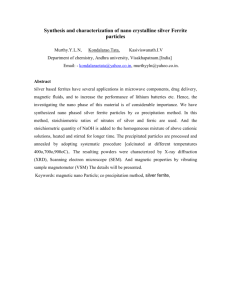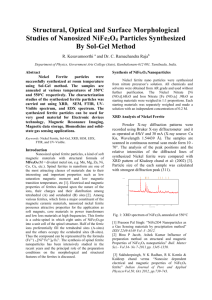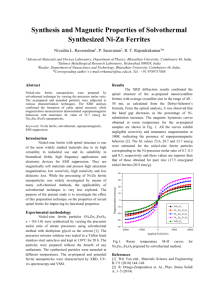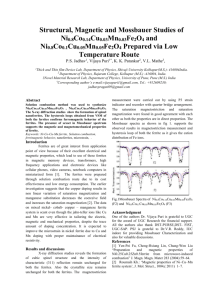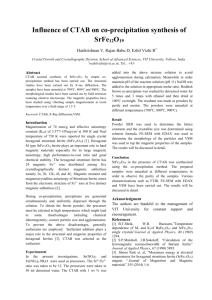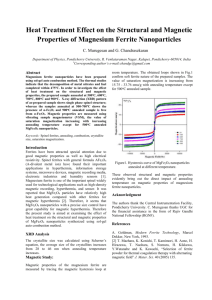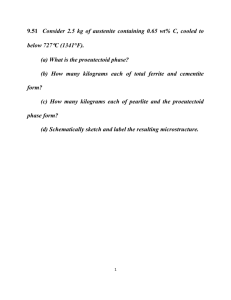SPECIFIC HEAT OF NICKEL-ZINC SYSTEM FERRITES IN THE
advertisement
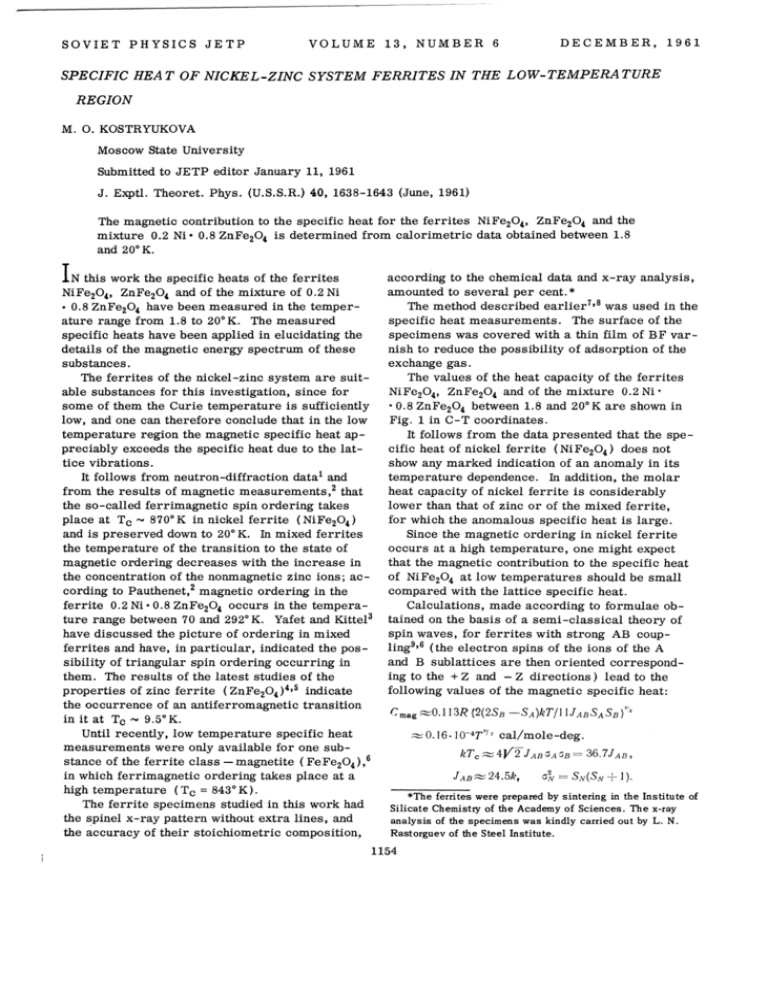
SOVIET PHYSICS JETP
DECEMBER, 1961
VOLUME 13, NUMBER 6
SPECIFIC HEAT OF NICKEL-ZINC SYSTEM FERRITES IN THE LOW-TEMPERATURE
REGION
M. 0. KOSTRYUKOVA
Moscow State University
Submitted to JETP editor January 11, 1961
J. Exptl. Theoret. Phys. (U.S.S.R.) 40, 1638-1643 (June, 1961)
The magnetic contribution to the specific heat for the ferrites NiFe 20 4 , ZnFe 20 4 and the
mixture 0.2 Ni • 0.8 ZnFe 20 4 is determined from calorimetric data obtained between 1.8
and 20°K.
IN this work the specific heats of the ferrites
NiFe 20 4 , ZnFe 20 4 and of the mixture of 0.2 Ni
• 0.8 ZnFe 20 4 have been measured in the temperature range from 1.8 to 20° K. The measured
specific heats have been applied in elucidating the
details of the magnetic energy spectrum of these
substances.
The ferrites of the nickel-zinc system are suitable substances for this investigation, since for
some of them the Curie temperature is sufficiently
low, and one can therefore conclude that in the low
temperature region the magnetic specific heat appreciably exceeds the specific heat due to the lattice vibrations.
It follows from neutron -diffraction data 1 and
from the results of magnetic measurements, 2 that
the so-called ferrimagnetic spin ordering takes
place at Tc ~ 870° K in nickel ferrite ( NiFe 20 4 )
and is preserved down to 20° K. In mixed ferrites
the temperature of the transition to the state of
magnetic ordering decreases with the increase in
the concentration of the nonmagnetic zinc ions; according to Pauthenet, 2 magnetic ordering in the
ferrite 0.2 Ni • 0.8 ZnFe 20 4 occurs in the temperature range between 70 and 292° K. Yafet and Kittel 3
have discussed the picture of ordering in mixed
ferrites and have, in particular, indicated the possibility of triangular spin ordering occurring in
them. The results of the latest studies of the
properties of zinc ferrite ( ZnFe 20 4 ) 4 •5 indicate
the occurrence of an antiferromagnetic transition
in it at Tc ~ 9.5° K.
Until recently, low temperature specific heat
measurements were only available for one substance of the ferrite class -magnetite ( FeFe 20 4 ), 6
in which ferrimagnetic ordering takes place at a
high temperature ( T c = 843° K).
The ferrite specimens studied in this work had
the spinel x-ray pattern without extra lines, and
the accuracy of their stoichiometric composition,
according to the chemical data and x-ray analysis,
amounted to several per cent.*
The method described earlier 7• 8 was used in the
specific heat measurements. The surface of the
specimens was covered with a thin film of BF varnish to reduce the possibility of adsorption of the
exchange gas.
The values of the heat capacity of the ferrites
NiFe 20 4 , ZnFe 20 4 and of the mixture 0.2 Ni •
• 0.8 ZnFe 20 4 between 1.8 and 20° K are shown in
Fig. 1 in C-T coordinates.
It follows from the data presented that the specific heat of nickel ferrite ( NiFe 20 4 ) does not
show any marked indication of an anomaly in its
temperature dependence. In addition, the molar
heat capacity of nickel ferrite is considerably
lower than that of zinc or of the mixed ferrite,
for which the anomalous specific heat is large.
Since the magnetic ordering in nickel ferrite
occurs at a high temperature, one might expect
that the magnetic contribution to the specific heat
of NiFe 20 4 at low temperatures should be small
compared with the lattice specific heat.
Calculations, made according to formulae obtained on the basis of a semi-classical theory of
spin waves, for ferrites with strong AB coupling9•6 (the electron spins of the ions of the A
and B sublattices are then oriented corresponding to the + Z and - Z directions ) lead to the
following values of the magnetic specific heat:
=0.16·10- T'
4
1'
cal/mole-deg.
JAB=24.5k,
*The ferrites were prepared by sintering in the Institute of
Silicate Chemistry of the Academy of Sciences. The x-ray
analysis of the specimens was kindly carried out by L. N.
Rastorguev of the Steel Institute.
1154
SPECIFIC HEAT OF NICKEL-ZINC SYSTEM FERRITES
1155
C, cal/mole-deg
I
I
I
I
I
I
0 / ·' _,.
5
8
10
12
'"
FIG. 1
C/T\ cal/mole-deg%
0
I.S·tl3t - - - - - - - - + - - - - - - - + - - - - - - - + - - - o - - - - - l
~'p
oo
c
0
t~·m~~------+-------+--~~~---+------~
Here SA and SB are the mean electron spins associated with the ionic moments of the tetrahedral
and octahedral lattice sites, which for nickel ferrite are taken respectively as 1.75 and 2.5; JAB
is the negative exchange integral between nearest
neighbor spins of the two sublattices. For the calculation, Tc is taken as 870° K.
In order to separate the magnetic specific heat
from that due to the lattice vibrations, the results
for nickel ferrite between 2 and 20° K are plotted
in Fig. 2 as C/T312 against T 312.* The straight
*More detailed data on the specific heat of NiFe 2 0 4 are
given elsewhere. 10
line drawn through the experimental points corresponds to a specific heat between 2 and 12° K given
by the expression
C[cal/mole-deg.] = 0,14·10- 4 P
+ 0.16·10-q'l,,
where the cubic term naturally describes the lattice specific heat ( ®n = 321 o K) and the term proportional to T 312 the magnetic specific heat.
We can thus consider that the experimental data
for nickel ferrite do not contradict the results of
the calculation, and the magnetic specific heat between 2 and 20° K represents a small fraction of
the lattice specific heat. In what follows, the esti-
M. 0. KOSTRYUKOVA
1156
mate of the specific heat corresponding to the lattice vibrations of zinc and of the mixed ferrites
has been made according to the data obtained for
nickel ferrite.
It should be noted that our data on the lattice
specific heat of NiFe 20 4 are close to the lattice
specific heat of magnetite ( FeFe 20 4 ), 6 for which
Clattice = 0.112 x 10-4 T3 cal/mole-deg. However,
the magnetic specific heat of magnetite, proportional to T 312 (see reference 6), is roughly 20
times greater than the magnetic contribution to
the specific heat of NiFe 20 4 • It is possible that
this is connected with the existence of the a-{3
transition in magnetite at 113° K. 11
An anomaly was found in the C-T curve (Fig. 1)
for the mixed nickel-zinc ferrite 0.2 Ni · 0.8 ZnFe 20 4 ,
with a maximum at a temperature "'9. 7° K. An
analogous anomaly in specific heat was found in
mixed nickel-zinc ferrites by Westrum and
Grimes, 12 and is probably connected with the
antiferromagnetic transition in zinc ferrite at
"'9.5o K.4,5
From the data shown in Fig. 3, where the coordinates are C/T312 and T 312, it follows that the
specific heat of the ferrite 0.2 Ni • 0.8 ZnFe 20 4
can be represented by the following formula between 1.8 and 4° K:
C[ cal/mole-deg.]
= 4,5·10-4 P
+ 2.5·10-2 T'i•.
The cubic term separated out in this way cannot, however, be ascribed solely to the lattice specific heat, since for nickel ferrite the lattice specific heat is 32 times smaller than the cubic term
in the specific heat of the mixed nickel-zinc ferrite.
The term in the heat capacity of the ferrite
0.2 Ni • 0.8 ZnFe 20 4 which is proportional to T 312
exceeds the cubic term over a large part of the
range of measurements (up to l4°K). Between 4
and 9. 7° K the experimental data are close to the
value of the term proportional to T 312, while above
9. 7° K the growth in specific heat is considerably
slowed down.
We can, therefore, consider that an appreciable
part of the magnetic specific heat between 1.8 and
4° K is connected with the ordering which takes
place below 9. 7° K in the mixed nickel-zinc ferrite.
It is also seen from the data that the magnetic
specific heat of the mixed nickel-zinc ferrite continues to increase with increasing temperature
between 9.7 and 20°K (Fig. 1). This indicates that
magnetic ordering in the mixed ferrite is preserved
at higher temperatures and that the specific heat
has a maximum lying above 20° K.
The maximum in the specific heat of the zinc
ferrite we measured was found at 9.5° K; at this
temperature the value is of the order of 3.5 cal/
mole-deg. The experimental data shown in Fig. 4
for temperatures between 1.8 and 4° K, in C/T312
and T 312 coordinates, enable one to express the
specific heat by the relation
C[ cal/mole-deg .] = 1.8. I o-a P
2
The cubic term in the specific heat of zinc ferrite exceeds appreciably both the lattice specific
heat of nickel ferrite (by 130 times) and the
cubic contribution to the specific heat of the mixed
nickel-zinc ferrite (by 4 times ) .
The T 312 term in the specific heat of nickel
ferrite is 4.8 times greater than the T 312 term in
the mixed ferrite.
The absence of a complete theory describing
the state of magnetic ordering in zinc ferrite and
in mixed nickel-zinc ferrites makes a comparison
of the experimental data with theory difficult. The
energy spectrum of antiferromagnets predicted by
theory leads to a cubic temperature dependence of
the magnetic specific heat in the region of not too
low temperatures 13 (for temperatures greater than
the gap in the energy spectrum of the antiferromagnet) and cannot explain the T 312 law.
At the same time, bearing in mind the fact that
the T 312 term in the magnetic specific heat is large
in zinc ferrite, we might think that both the cubic
term and the T 312 term in the magnetic specific
heat are due to antiferromagnetic ordering in
ZnFe 20 4 •
In the process of preparation, zinc ferrite is
always partly inverted. 2• 14 A certain fraction of
lOOC/T%, cal/mole-deg%
O,ZNLO.BZnFe,o,
3
"'
2
1
I
2
+ 12 .I . I o- T'''·
3
5
FIG. 3
6
SPECIFIC HEAT OF NICKEL-ZINC SYSTEM FERRITES
1157
lOOC/T%, cal/mole-deg51,
ZnFeA
!5
,..,p 0
..0
1J
n
0
•u
10 f-
I
I
I
I
2
J
4
I
5
5
'
7
I
,.. .
0 T~, K
FIG. 4
the Zn ions of the A sublattice then changes place
with the Fe ions of the B sublattice. The magnetic ordering may then be more complicated than,
for example, the triangular type suggested by
Yafet and Kittel 3 for mixed nickel-zinc ferrites
with small Ni concentration.
It is highly likely that a considerable part of
the T 312 specific heat is connected with this more
complicated form of magnetic ordering, which
takes place at low temperatures in different regions of a zinc ferrite specimen. The maximum
specific heat at"' 9. 7° Kin the mixed nickel-ferrite
0.2 Ni • 0.8 ZnFe 20 4 is possibly produced by inclusions of the zinc ferrite type.
In conclusion, I express my sincere thanks to
A. I. Shal'nikov for his constant interest in the
work, to A. S. Borovik-Romanov, who took part
in the discussion of the results, and to E. F.
Gippius for help with the experiments.
1 J. M. Hastings and L. M. Corliss, Revs. Modern Phys. 25, 114 (1953).
2 R. Pauthenet, Ann. de Phys. 7, 710 (1952).
3 Y. Yafet and C. Kittel, Phys. Rev. 87, 290
(1952).
4 J. M. Hastings and L. M. Corliss, Phys. Rev.
102, 1460 (1956).
5 E. F. Westrum, Jr. and D. M. Grimes, J. Phys.
Chem. Solids 3, 44 (1957).
6 J. S. Kouvel, Phys. Rev. 102, 1489 (1956).
7 M. 0. Kostryukova, Doklady Akad. Nauk SSSR
96, 959 (1954).
8 M. 0. Kostryukova, JETP 30, 1162 (1956),
Soviet Phys. JETP 3, 771 (1956).
9 H. Kaplan, Phys. Rev. 86, 121 (1952).
10 M. 0. Kostryukova and T. A. Leistner
BecTHHK MrY (Moscow State University Bulletin)
4 (1961).
11 S. V. Vonsovskii, CoBpeMeHHoe yqeHwe o
MarHeTH3Me (Modern Theories of Magnetism)
part III, Uostekhizdat, 1953, Sec. 13.
12 E. F. Westrum Jr. and D. M. Grimes, J. Phys.
Chem. 61, 761 (1957).
13 Akhiezer, Bar'yakhtar, and Kaganov, Usp. Fiz.
Nauk 71, 533 (1960), Soviet Phys. Uspekhi 3, 567
(1961).
14 E. F. Westrum Jr. and D. M. Grimes, J. Phys.
Chem. Solids 6, 280 (1958).
Translated by R. Berman
280
